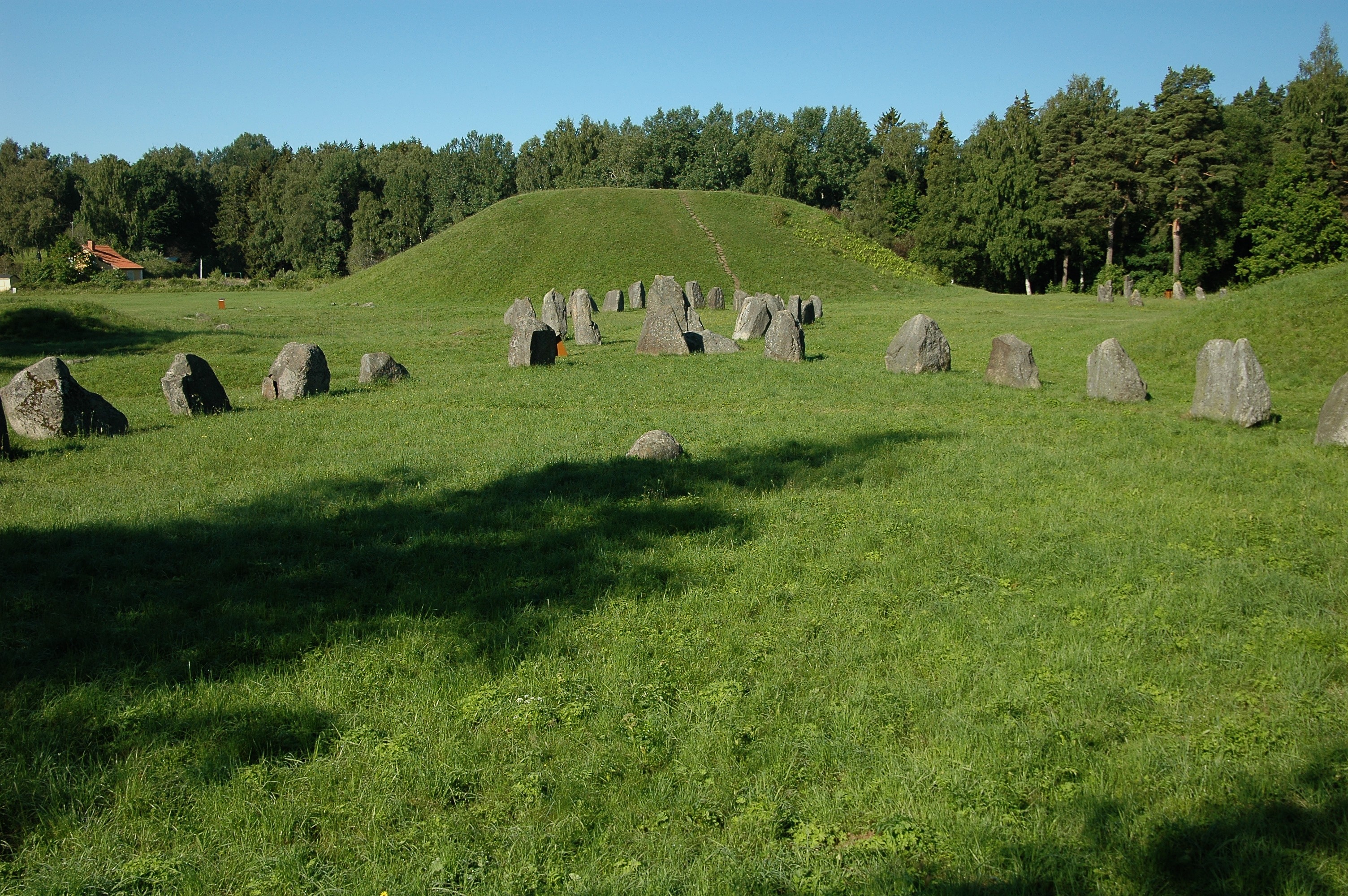Anundshög on:
[Wikipedia]
[Google]
[Amazon]
 Anundshög (also ''Anundshögen'' and ''Anunds hög'') is a
Anundshög (also ''Anundshögen'' and ''Anunds hög'') is a
p. 98
At the foot of the mound are 2 large
p. 130
File:Anundshög, Västerås1002.jpg, Stone ships
File:Anundshög, Västerås1000.jpg, Anundshög runestone, Vs 13
File:Anundshög, Västerås1010.jpg, Runestone and some of the line of stones marking
Anundshög homepage
*Jouni Tervalampi
Vikingarnas landskap, Fotevikens Museum
Anundshögen
Runstenar i Sverige, Swedish National Heritage Board {{DEFAULTSORT:Anundshog Archaeological sites in Sweden Västmanland Kurgans Germanic archaeological artifacts Geography of Västmanland County Buildings and structures in Västmanland County Tourist attractions in Västmanland County
 Anundshög (also ''Anundshögen'' and ''Anunds hög'') is a
Anundshög (also ''Anundshögen'' and ''Anunds hög'') is a tumulus
A tumulus (plural tumuli) is a mound of earth and stones raised over a grave or graves. Tumuli are also known as barrows, burial mounds or ''kurgans'', and may be found throughout much of the world. A cairn, which is a mound of stones bu ...
near Västerås
Västerås ( , , ) is a city in central Sweden on the shore of Lake Mälaren in the province of Västmanland, west of Stockholm. The city had a population of 127,799 at the end of 2019, out of the municipal total of 154,049.
Västerås is the se ...
in Västmanland
Västmanland ( or ), is a historical Swedish province, or ''landskap'', in middle Sweden. It borders Södermanland, Närke, Värmland, Dalarna and Uppland.
Västmanland means "(The) Land of the Western Men", where the "western men" (''väst ...
, the largest in Sweden. It has a diameter of and is about high.
Assessments of the era of the mound vary between the Bronze Age
The Bronze Age is a historic period, lasting approximately from 3300 BC to 1200 BC, characterized by the use of bronze, the presence of writing in some areas, and other early features of urban civilization. The Bronze Age is the second prin ...
and the late Iron Age
The Iron Age is the final epoch of the three-age division of the prehistory and protohistory of humanity. It was preceded by the Stone Age ( Paleolithic, Mesolithic, Neolithic) and the Bronze Age ( Chalcolithic). The concept has been mostl ...
. A fireplace under it has been dated by radiocarbon dating to sometime between AD 210 and 540.
Some historians have associated the mound with the legendary King Anund
Anund sv, Bröt-Anund meaning ''trail-blazer Anund'' or ''Anund the Land Clearer''; alternate names ''Brøt-Anundr'' (Old East Norse) or ''Braut-Önundr'' (Old West Norse) was a semi-legendary Swedish king of the House of Yngling who reigne ...
, while others regard this as speculative. It is purported also that the name is taken from the large runestone at the site, (Vs 13) the central stone in a row of 15 alongside the mound, re-erected in the 1960s and apparently marking out the route of the Eriksgata
Eriksgata (i.e. "Erik's Road") is the tour traditionally taken in the Middle Ages by a newly-elected Swedish king through the important provinces of the realm to have his election confirmed by the local assemblies. The actual election took place ...
. The inscription on the runestone reads:
: + fulkuiþr + raisti + stainn + þasi + ala + at + sun + + sin + hiþin + bruþur + anutaʀ + uraiþr hik + runaʀ
: "Folkvid raised all of these stones after his son Heden, Anund's brother. Vred carved the runes."Magnús Magnússon, ''Vikings!'', New York: Dutton, 1980, p. 98
At the foot of the mound are 2 large
stone ship
The stone ship or ship setting was an early burial custom in Scandinavia, Northern Germany, and the Baltic states. The grave or cremation burial was surrounded by slabs or stones in the shape of a boat or ship. The ships vary in size and were e ...
s placed end to end, and long. The site was a thing
Thing or The Thing may refer to:
Philosophy
* An object
* Broadly, an entity
* Thing-in-itself (or ''noumenon''), the reality that underlies perceptions, a term coined by Immanuel Kant
* Thing theory, a branch of critical theory that focuse ...
-place and the ship settings may be associated with this function.''Vendel Period Studies: Transactions of the Boat-Grave Symposium in Stockholm, February 2–3, 1981'', ed. Jan Peder Lamm and Hans-Åke Nordstrom, Statens Historiska Museum Studies 2, Stockholm: Statens Historiska Museum, 1983, p. 130
Eriksgata
Eriksgata (i.e. "Erik's Road") is the tour traditionally taken in the Middle Ages by a newly-elected Swedish king through the important provinces of the realm to have his election confirmed by the local assemblies. The actual election took place ...
References
External links
Anundshög homepage
*Jouni Tervalampi
Vikingarnas landskap, Fotevikens Museum
Anundshögen
Runstenar i Sverige, Swedish National Heritage Board {{DEFAULTSORT:Anundshog Archaeological sites in Sweden Västmanland Kurgans Germanic archaeological artifacts Geography of Västmanland County Buildings and structures in Västmanland County Tourist attractions in Västmanland County